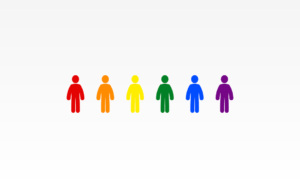In a world where the conversation surrounding gender identity is continually evolving, understanding the nuances and intricacies of gender dysphoria becomes not just relevant, but essential. As more and more individuals find the courage to voice their experiences, the narratives surrounding gender dysphoria unfold in various dimensions, portraying a tapestry of challenges, triumphs, and resilience. Through this blog, we intend to shine a light on the complex realities of gender dysphoria, fostering a space of empathy, awareness, and understanding.
Contents
Is Gender Dysphoria A Mental Disorder?
 Gender dysphoria, as classified by the American Psychiatric Association in the Diagnostic and Statistical Manual of Mental Disorders (DSM-5), is a mental health condition. In this, individuals experience a marked distress or incongruence between their experienced gender and the gender assigned to them at birth.
Gender dysphoria, as classified by the American Psychiatric Association in the Diagnostic and Statistical Manual of Mental Disorders (DSM-5), is a mental health condition. In this, individuals experience a marked distress or incongruence between their experienced gender and the gender assigned to them at birth.
It’s important to emphasize that this designation is based on the presence of distress that might accompany the incongruence, rather than the incongruence itself. The classification as a mental disorder can facilitate access to necessary medical and psychological support for people undergoing gender transition, including hormone therapy or surgeries.
However, the classification of gender dysphoria as a mental disorder has been a topic of ongoing debate within both the medical community and among advocacy groups. Many argue that labeling the distress and experiences associated with gender incongruence as a “disorder” can pathologize a natural variation of human experience And potentially reinforce stigma and misunderstanding. It is an evolving field, and perspectives are likely to continue to change and develop with further research and societal progress.
What Are The Signs Of Gender Dysphoria?
Gender dysphoria manifests in a variety of ways, often profoundly affecting an individual’s well-being and day-to-day life. It can be experienced by children, adolescents, and adults, with signs sometimes varying greatly among different age groups.
Here are some common signs to know:
- Strong Identification with Another Gender: Individuals might consistently express a strong identification with a gender different from the one assigned at birth.
- Distress with Physical Characteristics: A profound distress with physical characteristics, including secondary sexual characteristics, that do not align with the individual’s experienced gender.
- Discomfort with Gender Roles: People with gender dysphoria might feel an intense discomfort with the social roles and expectations associated with their assigned gender. And, preferring to adopt the roles traditionally ascribed to another gender.
- Depression and Anxiety: The distress and incongruence might lead to mental health issues such as depression and anxiety. Individuals grapple with their gender identity in a society that might not fully understand or accept it.
- Social Withdrawal: In some cases, the individual might avoid social situations and activities to prevent being perceived as their assigned gender, which can sometimes lead to isolation and withdrawal.
- Preference for Clothing and Accessories: A persistent preference for clothing, accessories, and hairstyles that are typically associated with a gender different from the one assigned at birth.
- Vocal Expression: An effort to change one’s voice to better align with the gender they identify with. This might include alterations in pitch, resonance, or language use.
- Behavioral and Interest Changes: Children might prefer games, toys, and activities that are stereotypically associated with the gender they identify with. And they might avoid games and activities traditionally linked to their assigned gender.
It is essential to approach individuals experiencing signs of gender dysphoria with empathy and understanding.
What Is The Main Cause Of Gender Dysphoria?
 The exact cause of gender dysphoria remains not fully understood. Hence, it likely involves a complex interplay of biological, environmental, and social factors. Here is a more detailed exploration of these aspects:
The exact cause of gender dysphoria remains not fully understood. Hence, it likely involves a complex interplay of biological, environmental, and social factors. Here is a more detailed exploration of these aspects:
Biological Factors
Researchers have proposed that biological elements such as genetics, hormonal influences during fetal development, and neurological variations could play a role in the development of gender dysphoria. Scientific studies have suggested that there might be structural and functional differences in the brains of individuals who experience gender dysphoria.
Environmental Factors
The role of environmental factors in the development of gender dysphoria is still a topic of ongoing research. Early childhood experiences, family dynamics, and cultural influences might contribute to the development of gender dysphoria.
Social Factors
Social factors such as cultural norms, societal expectations, and the influence of peer groups and communities can shape an individual’s perception of gender and might play a role in the development of gender dysphoria. The societal construct of gender roles and expectations might influence individuals’ experiences of gender incongruence and distress.
Psychological Factors
Psychological factors might also contribute to gender dysphoria. The personal perception of one’s own gender and the distress stemming from the incongruence between one’s experienced gender and the assigned gender at birth can create a psychological conflict that manifests as gender dysphoria.
In essence, the cause of gender dysphoria is multifaceted, involving a blend of biological, environmental, and social elements. It is essential to approach this topic with a nuanced understanding, recognizing that individual experiences can vary greatly.
Can You Self-Diagnose Gender Dysphoria?
 Self-diagnosing any condition, including gender dysphoria, can be a precarious avenue. This is mainly because an accurate diagnosis often requires a comprehensive evaluation by trained professionals. In the case of gender dysphoria, professionals generally have the tools and expertise to assess the condition in a nuanced manner.
Self-diagnosing any condition, including gender dysphoria, can be a precarious avenue. This is mainly because an accurate diagnosis often requires a comprehensive evaluation by trained professionals. In the case of gender dysphoria, professionals generally have the tools and expertise to assess the condition in a nuanced manner.
That being said, an individual can certainly recognize signs of gender dysphoria in themselves, such as:
- persistent discomfort with their assigned gender
- a strong identification with another gender
- distress related to physical characteristics that do not align with their experienced gender
These self-observations can be a significant first step in understanding one’s own gender identity. If someone suspects that they might be experiencing gender dysphoria, it is generally recommended to consult with a healthcare provider who specializes in gender and sexuality. Such providers can help to clarify the diagnosis and discuss potential paths for support and treatment if necessary.
What Treatments Are Available?
The treatment and management of gender dysphoria is highly individualized, as it needs to suit the specific needs and wishes of each person. Here is an overview of some potential treatments and interventions that might be available:
- Individual Therapy: Counseling with a therapist experienced in gender identity issues can help individuals explore their gender identity, navigate transition processes, and manage any associated distress or mental health issues.
- Family Therapy: It can assist families in understanding and supporting a loved one during their transition.
- Support Groups: Peer support groups can provide a space to share experiences and advice with others who have similar experiences.
- Hormone Therapy: Involves the administration of gender-affirming hormones (testosterone or estrogen) to help align physical characteristics with one’s gender identity.
- Surgeries: Depending on the individual’s needs and desires, various surgeries might be considered, including chest/breast surgery, genital reconstruction surgery, and facial feminization surgery, among others.
- Social Transition: Involves living as one’s experienced gender in daily life. This might include changing one’s name, pronouns, and clothing style.
- Comprehensive Healthcare: Ensuring access to healthcare that considers all aspects of an individual’s well-being. And, including preventive care and management of any other health conditions.
- Lifestyle and Well-being: Engaging in activities that promote well-being, like cultivating hobbies, maintaining a balanced lifestyle, and fostering supportive relationships.
- Advocacy and Education: Working to promote understanding and acceptance of transgender and gender-diverse individuals in society.
It is essential that individuals work closely with a healthcare team that has expertise in gender health to develop a personalized treatment plan. Finally, it is also crucial that treatment is based on informed consent, with open communication between individuals and their healthcare providers.
How To Support A Loved One With Gender Dysphoria?
Supporting a loved one with gender dysphoria involves a combination of empathy, education, and active engagement. Here are some strategies and steps to consider:
1. Educate Yourself
- Understanding Gender Dysphoria: Learn about what gender dysphoria is, its signs, and its potential impact on an individual.
- Language Sensitivity: Understand the importance of using the correct pronouns and names.
2. Communicate Openly and Respectfully
- Active Listening: Engage in conversations where you listen more to understand their experiences and feelings.
- Non-Judgmental Approach: Avoid judging or making assumptions about their experiences.
3. Emotional Support
- Offer Affirmation: Affirm their identity by respecting their self-identified name and pronouns.
- Empathy and Compassion: Show empathy and compassion in your interactions.
4. Creating a Safe Space
- Safe Environment: Help to create a safe and supportive environment where they can express themselves freely.
- Challenge Discrimination: Stand up against discriminatory behaviors or comments from others.
5. Encouraging Well-being
- Encourage Self-Care: Encourage them to take care of their mental and physical well-being.
- Supportive Networks: Help them to connect with support networks or groups where they can meet others with similar experiences.
6. Maintaining Privacy
- Respect Privacy: Respect their privacy and allow them to disclose their gender identity to others at their own pace.
- Confidentiality: Maintain confidentiality about their gender identity unless they have given explicit permission to share.
7. Seeking Support for Yourself
- Self-Education: Continuously educate yourself on evolving gender issues and terminologies.
- Support Groups: Consider joining support groups or forums to connect with others who are also supporting loved ones with gender dysphoria.
Remember, the most important aspect is to approach your loved one with love, respect, and an open mind. Also, make sure to be there for them in their journey towards living as their authentic self.
Conclusion
In the intricate tapestry of human experience, understanding gender dysphoria stands as a testament to the importance of empathy, knowledge, and open-heartedness. From recognizing the signs to exploring treatments, and most importantly, supporting our loved ones, each facet of this journey emphasizes the power of validation and the profound impact of acceptance.
As society evolves, it remains imperative that we champion a world where each individual feels seen, understood, and cherished for their authentic selves. Life may sometimes be challenging if you are transgender, but Online Transgender Counseling can help. Get experienced LGBTQ therapists at MantraCare: Book a trial LGBTQ therapy session


